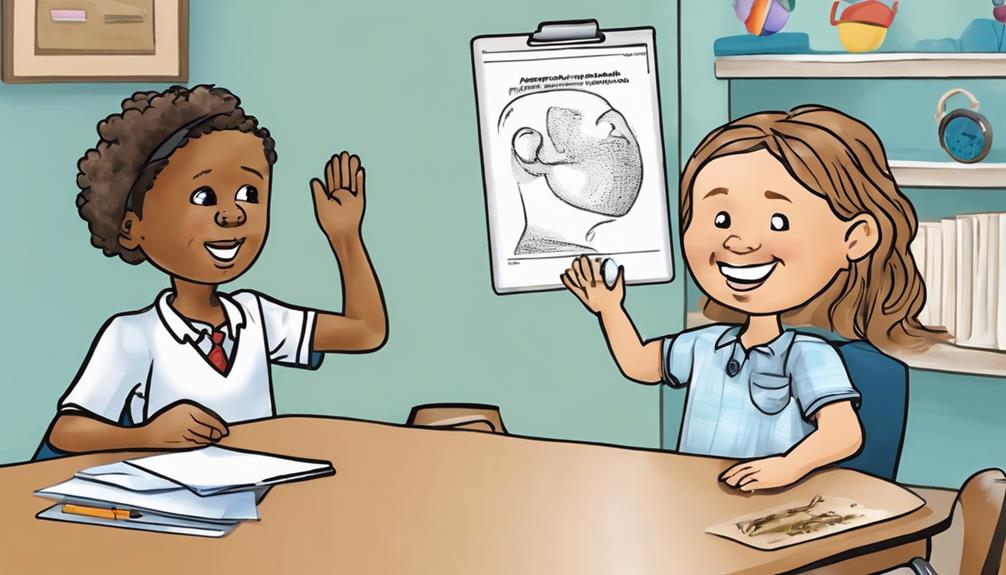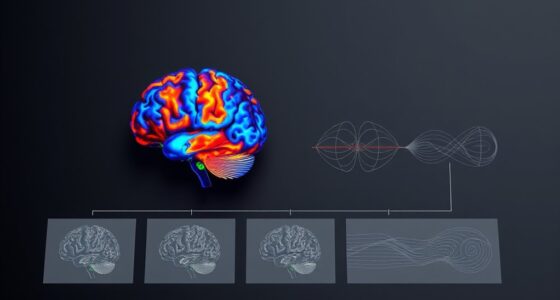In the vast landscape of auditory processing improvement, these 7 Speech Therapy Techniques act as guiding stars, illuminating the path towards enhanced communication skills and comprehension.
As we explore each technique's unique role in unraveling the complexities of auditory processing challenges, we invite you to join us in uncovering practical strategies that can make a profound difference in how individuals perceive and engage with the auditory world around them.
Let's embark on this journey together, where every technique holds the potential to transform the way we approach auditory processing improvement.
Key Takeaways
- Enhance auditory discrimination and memory recall for improved speech comprehension.
- Strengthen phonological awareness and sound processing abilities through sound blending and word pair practice.
- Develop auditory processing skills, memory, and organization through sequencing and pattern recognition tasks.
- Focus on listening comprehension, vocabulary building, and communication skills development in speech therapy techniques.
Auditory Discrimination Activities
Engaging in regular auditory discrimination activities sharpens our ability to distinguish between similar sounds or phonemes, enhancing overall auditory processing skills. These activities play a crucial role in improving our speech and language comprehension by training the brain to identify subtle differences in sound patterns. By focusing on tasks like recognizing minimal pair words, distinguishing rhyming words, and differentiating consonant sounds, individuals can enhance their auditory skills significantly. Such exercises not only help in refining listening abilities but also promote better understanding of spoken language.
Through consistent practice of auditory discrimination tasks, individuals can experience improvements in speech perception and communication skills. For those facing challenges with auditory processing, these activities offer a structured approach to enhance their ability to interpret and respond to speech sounds accurately. By honing our auditory discrimination skills, we pave the way for more effective communication and richer language comprehension.
Auditory Memory Exercises

When it comes to improving auditory memory, memory recall techniques and auditory sequencing practice play a crucial role.
These exercises aim to enhance the ability to remember and process auditory information effectively.
Memory Recall Techniques
Enhancing auditory memory through specific exercises is a key focus in speech therapy for improving information retention and comprehension. These auditory memory exercises target both short-term and long-term memory, enhancing recall abilities and sharpening listening skills.
Structured tasks like repeating sequences of sounds, words, or sentences challenge memory capacity and boost retention. Speech therapists employ games and activities to make the process engaging while effectively strengthening memory recall.
Consistent practice of these exercises leads to notable enhancements in processing and accurately recalling spoken information. By honing memory recall techniques, individuals can significantly improve their ability to retain and comprehend auditory information, fostering better communication skills and overall cognitive development.
Auditory Sequencing Practice
To enhance auditory memory and processing skills, auditory sequencing practice involves targeted exercises aimed at improving the accurate recall of sequences of sounds, words, or instructions.
These memory exercises are designed to strengthen cognitive functions and enhance auditory processing abilities, particularly beneficial for individuals with auditory processing disorder.
Speech therapists utilize techniques such as repeating sequences, pattern recognition, and story retelling to enhance auditory sequencing skills.
By engaging in these exercises, individuals can better comprehend and retain spoken information, leading to improved communication and overall auditory processing.
Practicing auditory sequencing is a vital component of speech therapy for individuals looking to enhance their auditory memory and processing capabilities under the guidance of skilled speech therapists.
Sound Blending Techniques
When it comes to improving auditory processing through sound blending techniques, it's essential to focus on blending sounds effectively to enhance phonological awareness.
By practicing with word pairs, children can strengthen their ability to merge individual sounds into meaningful words.
Visual aids can also play a crucial role in reinforcing sound blending skills and aiding in the comprehension of auditory information.
Blending Sounds Effectively
In developing strong auditory processing skills, mastering the art of blending sounds effectively through sound blending techniques is crucial. Sound blending techniques in speech therapy play a vital role in helping individuals with auditory processing problems improve their phonological awareness and language comprehension.
By combining individual sounds to form words, these techniques enhance the ability to decode words accurately. Speech therapists often use activities like blending syllables and phonemes to strengthen sound blending skills in children struggling with auditory processing.
Practicing sound blending exercises not only aids in improving speech recognition skills but is also essential for developing robust reading abilities in individuals facing auditory processing difficulties. Sound blending techniques serve as a fundamental building block for enhancing overall auditory processing and language skills.
Practice With Word Pairs
Blending sounds effectively through word pairs practice is a key technique in improving auditory processing skills and enhancing speech comprehension.
Word pairs practice involves combining two distinct sounds to strengthen phonemic awareness and sound processing abilities. This structured exercise aids individuals, especially children with Auditory Processing Disorder (APD), in distinguishing between similar sounds and processing auditory information more effectively.
By engaging in sound blending techniques with word pairs, individuals can enhance their sound discrimination and speech perception skills. The repetition and focus required during word pairs practice contribute to the development of better auditory processing capabilities, leading to improved speech comprehension.
Use Visual Aids
Utilizing visual aids in sound blending techniques enhances the integration of auditory and visual cues for improved speech comprehension and language processing. Visual aids provide a valuable support system for auditory processing by offering a visual representation of sounds and words. Sound blending techniques, coupled with visual cues, can significantly enhance the ability to combine individual sounds into meaningful words. These aids support sound discrimination and auditory memory, leading to better comprehension. By incorporating pictures, gestures, or written words alongside auditory stimuli, individuals can strengthen their sound blending skills and enhance language processing. This multisensory approach fosters improved understanding by reinforcing auditory input with visual information. The table below illustrates the benefits of using visual aids in sound blending techniques:
| Benefits of Visual Aids in Sound Blending |
|---|
| Enhanced auditory processing |
| Improved sound blending skills |
| Better language comprehension |
| Support for auditory memory |
| Reinforcement of multisensory learning |
Sequencing and Pattern Recognition

Engaging in activities that focus on sequencing and pattern recognition can significantly enhance auditory processing skills by strengthening memory and organization abilities.
Sequencing activities, such as storytelling or following step-by-step instructions, improve auditory processing by enhancing memory and organizational skills.
Pattern recognition exercises, like identifying rhythms or completing sequences, aid in developing auditory discrimination and processing speed.
Musical activities, such as clapping patterns or playing instruments, can strengthen auditory processing abilities through rhythmic perception.
Additionally, sequencing games, such as arranging events in order or completing patterns in visuals, help improve auditory processing for better comprehension and retention.
Regular practice with sequencing and pattern recognition tasks can enhance cognitive processing and auditory memory, providing significant benefits for individuals with auditory processing disorders.
Listening Comprehension Strategies

Improving listening comprehension skills is a key focus of speech therapy techniques for auditory processing enhancement, particularly in children. Active listening exercises play a crucial role in enhancing listening comprehension. Therapists often emphasize repetition of key information and reinforcement of important words to aid in memory retention.
By working on comprehension of spoken information and the ability to follow directions, speech therapy aims to improve communication effectiveness. Adjusting speech rate, providing extra processing time, and creating a supportive communication environment are essential strategies employed. These techniques not only enhance understanding but also foster engagement in communication tasks.
Vocabulary Building Activities

Vocabulary building activities play a vital role in enhancing word recognition and understanding for children with auditory processing difficulties. These activities focus on expanding vocabulary through word associations, categorization, and context-based learning. Speech therapists utilize games, flashcards, and storytelling to engage children in vocabulary building exercises. Repetition and reinforcement are key components to enhance retention and recall of new words. These targeted interventions aim to boost language skills and support overall communication development in children facing auditory processing challenges.
| Vocabulary Activity | Description | Benefits |
|---|---|---|
| Word Associations | Connecting words with related concepts | Enhances cognitive skills |
| Categorization | Sorting words into groups based on common characteristics | Improves organizational skills |
| Context-Based Learning | Learning words within meaningful contexts | Facilitates better comprehension |
Engaging in these activities not only helps children broaden their vocabulary but also strengthens their language development skills.
Communication Skills Development

Communication skills development is a fundamental focus of speech therapy techniques aimed at enhancing auditory processing abilities for effective language interaction. In therapy services, individuals with auditory processing difficulties are guided to improve their communication abilities by honing their language skills and understanding of speech sounds.
Through tailored interventions, therapists help individuals strengthen their capacity to differentiate between various speech sounds and process auditory information accurately. By working on these essential skills, individuals can better engage in conversations, comprehend instructions, and participate actively in social interactions.
The strategies employed in speech therapy sessions are designed to support the overall development of communication skills, enabling individuals to navigate various communication challenges with increased confidence and proficiency. The ultimate goal is to equip individuals with the tools needed to communicate effectively in diverse settings and enhance their overall quality of life through improved communication abilities.
Frequently Asked Questions
How to Treat Auditory Processing Disorder in Speech Therapy?
When treating auditory processing disorder in speech therapy, we focus on improving sound distinction, memory, and sequencing skills crucial for understanding spoken information.
Techniques like sound discrimination training, auditory memory exercises, and language-processing strategies are employed to enhance auditory processing abilities.
Tailoring interventions to match the intensity and type of disorder allows for personalized approaches.
Multi-sensory learning techniques help children process auditory information more effectively and improve communication skills.
How Can Auditory Processing Be Improved?
Improving auditory processing involves targeted exercises and strategies that enhance sound discrimination, auditory memory, and language processing skills. By focusing on these areas, individuals can develop better listening comprehension and communication abilities.
Repetition, reinforcement, and structured interventions play a key role in enhancing auditory processing capabilities over time. Through personalized therapy plans, speech therapists work on improving auditory processing to support better understanding and retention of spoken information.
What Are the Intervention Strategies for Auditory Processing Disorder?
Intervention strategies for auditory processing disorder involve speech therapy techniques that target sound distinction, memory, and sequencing skills. Multi-sensory learning approaches are used to improve auditory information processing.
Speech-language therapists provide systematic instruction to help individuals manage frustration, build on strengths, and compensate for weaknesses. These strategies aim to enhance receptive language skills by addressing challenges in differentiating sounds, monitoring speech, and manipulating phonemes.
Early intervention and professional support are crucial for effective improvement.
What Is the Role of SLP in Auditory Processing Disorder?
In addressing the role of SLPs in auditory processing disorder, we focus on enhancing auditory discrimination, comprehension, and memory skills. By utilizing specialized techniques and collaborating with audiologists, SLPs create tailored treatment plans for each individual.
Through targeted therapy, we aim to improve listening, language, and communication abilities in various life settings. Advocating for individuals ensures access to necessary support services for optimal outcomes.
Conclusion
In conclusion, implementing speech therapy techniques for auditory processing improvement can significantly benefit individuals struggling with auditory processing disorders.
Did you know that approximately 5-7% of children have auditory processing difficulties that can impact their learning and communication skills?
By utilizing these 7 techniques, speech therapists can help individuals enhance their listening abilities, improve comprehension, and ultimately enhance their overall communication effectiveness.
It's crucial to support individuals with auditory processing challenges to help them thrive in various aspects of their lives.











